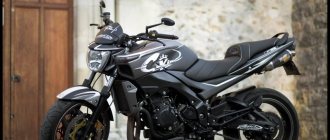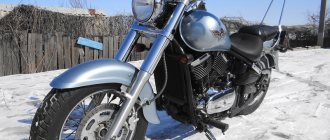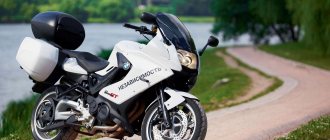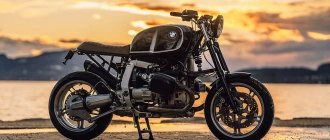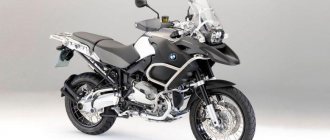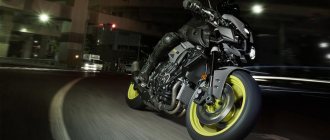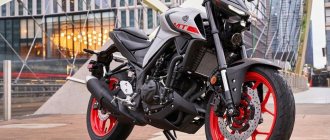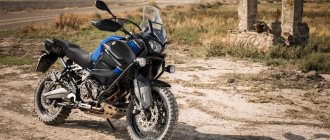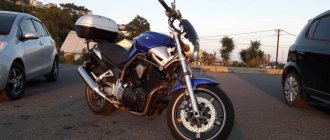History of the BMW Group
Few people are not familiar with the largest automobile concern BMW. Its history goes back more than 100 years. Back in 1896, the ambitious Heinrich Erhardt began making bicycles and military vehicles in Germany. But he soon realized that he could achieve more and released the first motorized carriage, Wartburg. As technology developed, cars also improved. From “carriages” they turned into the great-grandfathers of the cars to which we are accustomed. The First World War gave impetus to the development of mechanical engineering, and in 1917 the company received its traditional name, to which we are accustomed. BMW translates to "Bavarian Motor Works". In 1922, the company began producing motorcycles, which were based on a small-volume two-cylinder engine. Motorcycles have become much more powerful and lighter. In the following years, German manufacturers improved their models, giving them more and more advanced forms. In the 50s, their motorcycles could already accelerate to 160 km/h, becoming one of the fastest vehicles of that time. But the heyday of BMW came in the 90s. The new BMW 5 and 7 models thundered throughout the world and are still loved by thousands of people. BMWs remain one of the most reliable motorcycles in the world, because their engines are perfectly balanced and last for many years.
TEST DRIVE: Express test BMW F800ST (2011)
I opened the 2011 season with the BMW F800ST. Imagine: February, Spain, the very south - Malaga, and by the evening you need to be already in Valencia, then in Aragon, at the World Superbike tests, and, finally, on a plane in Madrid. How? Aragon is an eerie backwater even by Russian standards: 123 km to the nearest airport, taxi is “golden”.
MOTOGONKI.RU, November 18, 2011 — A solution was found. We, it seems, work for a motorcycle magazine, so renting a car and throwing up on a bus for a day is not our way! The F800ST turned out to be available at the nearest rental.
Test drive: BMW F800ST
First impressions behind the wheel - a bicycle! Narrow, small, light, nimble - urban, in a word. At the same time, the standard luggage system is the height of engineering: the side plastic trunks with a textile “accordion” easily double in volume with a slight movement of the hand. I scattered a huge saddle bag (76 liters) with excess equipment and other civilian clothes - I put some on myself, some went into my luggage, leaving room for a camera and a bunch of lenses. Such a long-range set for a city “switch”? It didn't fit in my head.
900 km along the Mediterranean coast - through the Mecca of winter motorsports Almeria, to Valencia, then north along mountain serpentines through Morella - to ancient Alcaniz. I don't remember a minute from the trip along the heavenly roads of the south. But I clearly remember the pleasure of the moderately wide, intricately twisted mountain highways of Costelón.
However, the dimensions of the F800ST do not interfere with riding for pleasure, for example, covering a thousand kilometers in Spain...
The BMW F800ST, which had difficulty maintaining its cruising speed of 160 km/h, perked up. 130 is his real “comfortable” one, in which driving gives maximum pleasure, and fuel consumption drops to 5 l/100 km. Still, for wild boars like me, a larger caliber is needed. BMW's inline double-barreled gun would suit someone with a more graceful build and shorter stature. In general, the 800ST is a unique combination of calm and capabilities, a sort of Mr. Nice Guy of the motorcycle world - you can't fault him. But because of this it is monstrously boring on the expressway, without any “light”. Salvation lies in the winding paths, where he can reach the asphalt with his knee on the first try.
How graceful Irina Skatkova looks in the saddle of the BMW F800ST!
Total
Small "ST" in size and design is more suitable for a small beginner - a girl? For a full-size guy driving this motorcycle it will be a bit cramped. If you want this type of motorcycle, you need the BMW F800GT. This is the same ST, but the design takes into account all my requests 
And here are my impressions of the BMW F800GT: Science and Art
First published in MOTOREVYU magazine 7/2011 Photos by the author
Technical characteristics of BMW motorcycles
BMW motorcycles, although not as famous as cars, are nevertheless winners of many competitions and races. Made in a brutal sporty style, they have such power that they can accelerate to hundreds of kilometers in a few seconds. The impressive history of the brand and excellent appearance add a special zest to trips around the city. BMW motorcycles are prefabricated models with many configurations. You can turn a sports bike into a touring bike with the help of accessories, and vice versa. The high handlebars and stable long frame are suitable even for tall people, and the motorcycles are designed to carry weights up to 225 kilograms. The hallmark of German motorcycles is the two-cylinder air-cooled engine, which the company's engineers invented back in 1922. Among BMW bikes, you cannot find models with a small engine capacity: all motorcycles are powerful and have a volume of over 600 cubic centimeters. The products are loved all over the world, and many motorcyclists prefer to ride exclusively on bikes with the signature white and blue logo.
BMW F800GT. Non-standard balance
Despite the GT prefix, this BMW is far from a Gran Turismo, but quite a compact, lightweight and not burdened with excessive comfort and all sorts of technological bells and whistles, like its older brothers, the K1600GT and R1200RT tourers. But it turned out to be even better
Natalya Umnova
Despite the GT prefix, this BMW is far from a Gran Turismo, but quite a compact, lightweight and not burdened with excessive comfort and all sorts of technological bells and whistles, like its older brothers-tourers K1600GT and R1200RT. And it turned out to be even better
BMW F800GT. Price: from 549,000 rub. On sale: since 2013
Photo by Alexey Voznyuk
In terms of roads and distances, the United States of America is associated with smooth straight lines going nowhere. And when you think about the motorcycles most suitable for such terrain, cruisers and tourers come to mind, with small sports tourers like the BMW F800GT being considered one of the last places. However, the reality, both geographical and technical, turned out to be different from the standards. For 3.5 thousand km in California, we drove straight for only 500 kilometers, everything else was inclined along serpentines of greater or lesser severity. It would be much more difficult to move a huge tourer on them than a light and rather short F800GT.
In these same endless turns, tilts and acceleration-braking, you especially begin to appreciate the belt drive, which ensures smooth and continuous transmission of torque (max 86 Nm) to the rear wheel without delays or jerking. Compared to the nervous chain naked F800R (“5th wheel” No. 9, 2012), which has the same engine, the difference is quite noticeable. In addition, the belt is more convenient when traveling because it does not need to be lubricated and tightened.
The in-line “two” under the extensive fairings shows not outstanding, but sufficient dynamics, and in any gear, so that at speeds above cruising (~140 km/h) you don’t always even need to shift down to overtake. Of the six gears, three are the most popular: second-third for driving around the city and sixth for highways. There is an indicator on the dashboard that the “speed” is on, so you won’t get confused where and how much to click.
The side panniers stick out beyond the dimensions of the mirrors - you need to watch them carefully, otherwise you might not be able to get out of the gate or hit the next car
BMW engineers have found the optimal wheelbase length for the F800GT: it's compact enough to weave through lanes in traffic and generally not be a nuisance in the city, but long enough to maintain a stable course at high speeds. This is also helped by the steering damper that comes as standard. The rigid chassis allows you to fearlessly roll the motorcycle into turns, and on the straights it keeps the device from shifting on the longitudinal seams and markings - you don’t notice them at all.
The trunks don't fit one person's luggage for a two-week trip, much less two people.
While the “jitishka” fork is not adjustable in any way, the spring of its rear shock absorber is clamped manually, and to change the rebound force there is an electronic ESA system: with a button on the steering wheel you can change the mode from Comfort to Normal or Sport. At “comfort”, the suspension logically becomes softer, so that small bumps and roughness of the road become less noticeable. In sports mode, all the pebbles are acutely felt, but control over the motorcycle in general and the behavior of the wheels in particular increases. A “normal” shutdown is something in between. It must be said that the noticeable difference in the behavior of the F800GT in different modes is directly proportional to the difference in the quality of the surface and changes in the track format. If you drive all the time on an equally flat, slightly winding road, then there is no point in touching the ESA button, unless out of boredom. But if the landscape often changes from straight lines to steep serpentines, or you drove from your dacha through the city to the race track, and along the way you regularly came across long pieces of torn off asphalt, then ESA will help make your trip safer and more comfortable.
You can tighten the shock absorber manually
By the way, about comfort. The riding position on the F800GT is standard for this type of motorcycle and will suit a variety of riders. The seat is of medium softness and width, its comfort is enough for 2-3 hours of driving, and then the butt or back still gets numb, depending on what. The ability to fidget back and forth helps a little if you are driving without a passenger, whose seat is almost more comfortable than the driver’s. Although after a couple of full days on horseback, your butt takes on the shape of a saddle, and you stop paying attention to it. During a long drive, your shoulders and legs don’t become numb, your arms don’t get very tired, only at speeds above 120 km/h does a small rattling sound begin on the steering wheel, which then causes your hands to shake slightly, and sometimes your fingers to go numb while driving. In this regard, the super-efficient engine - 3.5-4 liters per 100 km at a speed of 100-120 km/h (with increasing speed, consumption also increases) - plays against riders, because “justified” stops for refueling rarely happen, once every 3- 4 hours: I would like motorcycle trips to be as balanced as the BMW F800GT.
ABS brakes are predictable and easy to see
SPECIFICATIONS
| Dimensions (length/width/height/seat height) | 2156x905x1248x800 mm |
| Base | 1466 mm |
| Ground clearance | n.d. |
| Fuel tank volume | 15 (reserve 3 l) |
| Engine | 798 cm3, 4-stroke, 2-cylinder, liquid cooling, injection, 90/8000 hp/min-1, 86/5800 Nm/min-1 |
| Transmission | mechanical, 6-speed, belt drive |
| Frame | aluminum |
| Front suspension | telescopic fork, ∅43 mm, stroke 125 mm |
| Rear suspension | adjustable monoshock, 125 mm travel |
| Front/rear brake | 2 discs ∅320 mm / 1 disc ∅265 mm |
| Curb weight | 213 kg |
| Technologies | ABS, ESA (optional) |
The editors recommend:
How to reduce washer fluid consumption?
Russians will be able to catch traffic violators on their phones
Where is it better to store a car - in a garage or outside? Opinions for and against
Advanced truck driver and savings on service: what do cargo carriers rely on?
New law: fine drivers for speeding 5 km/h
Discussion Cancel
I want to receive the most interesting articles
Model history
The F800 series consists of two models. This:
- BMW F800ST: universal sport-tourer motorcycle;
- F800S: A sportier option.
Production of these bikes began in 2006, and in 2007 the F800S model was already removed from sale in most countries. The fact is that although these two motorcycles were produced as complementary to each other, they became competitors. Most buyers chose the 800ST model, which looked more like a sports bike, although the only differences were in the plastic. In 2010, the F800S was finally withdrawn from sale.
The BMW F800ST models differ from the rest of the motorcycle line due to their engine. It so happened that the two-cylinder, air-cooled engine became a classic for the German company. In the BMW F800ST motorcycle it was replaced by a two-cylinder in-line engine with liquid cooling. The goal of creating a line of 800 cc all-round bikes was comfort. To maintain excellent technical characteristics and at the same time make motorcycles less demanding on the level of pilots - this was the task that BMW engineers set themselves.
002_MOTO_0310_029
The mileage was 19,000 km over 3 years of operation.
The mileage was 19,000 km over 3 years of operation.
These 18 hours of travel and 1870 km were not easy. There were rains and hail, and a foggy dawn at the pass through the Carpathians, and my companion in the “Gold” “dried out” near Brest, not reaching the gas station a couple of kilometers (as a result, I had to go to the nearest gas station with a bottle and then bring him gasoline) . But it was really cool, I fully enjoyed the meaning of the term “sport-tourist” embedded in my motorcycle.
Technical specifications
The technical characteristics of the BMW F800ST have led to the fact that the motorcycle still sells well to this day. The powerful two-cylinder engine with a volume of 798 cubic centimeters is capable of developing a power of 85 horsepower. It is capable of developing considerable speed: up to 220 km/h can easily be accelerated on a straight road. The F800ST reaches 100 km/h in 3.7 seconds. The motorcycle is quite light for its class (185 kilograms), so it is maneuverable and easy to control.
The 800cc bike was conceived as a motorcycle that is as convenient as possible for all tasks. And I must say, the designers managed to make it a leader in comfort in its class. It is ideal for traveling around the city, but performs just as well on long-distance trains. A comfortable seat and a high steering wheel do not affect the spine, and heated handles and seats will save you in bad weather. The motorcycle is equipped with an ABS system and an on-board computer that shows tire pressure and all the necessary parameters.
What other features does the BMW F800ST have? Distinctive features include a front drive belt drive, which will save you from problems with replacing the chain. The 6-speed gearbox shifts gears smoothly, without jerking. The bike accelerates and decelerates like clockwork. The ride is very smooth thanks to the suspension, which smooths out all the bumps, and the unnoticeable operation of the engine.
005_MOTO_0310_031
My motorcycle is not just a vehicle, like, say, a car.
But this is not a toy for people to see and show off. This is a piece of my soul. My motorcycle is not just a vehicle, like, say, a car. But this is not a toy for people to see and show off. This is a piece of my soul.
Having ridden my friends’ motorcycles a couple of times and compared them with mine, I realized that I was right in choosing a motorcycle with my heart - women’s intuition did not disappoint. And after a couple of years, the conviction of the correctness of the choice only became stronger. Yes, I’m not a blonde, but I didn’t study the hardware and didn’t go into the design features of this device; I didn’t know why a belt is better than a chain and why a motorcycle needs so many buttons on the steering wheel. I understood all this later, after reading the instructions and studying all the functions. It turned out that the ergonomics of the steering switches are perfectly designed for small female hands, and the multifunctional instrument panel provides comprehensive information about the “health” and appetite of my gray horse. And having learned about the procedure for washing, tensioning and lubricating a chain, I once again thanked my motorcycle for the fact that it has a belt instead of a chain. But I know the buzzword - integrated ABS system. It not only sounds beautiful, but also works great—it saved me from falling a couple of times on a slippery road.
Model modifications
When choosing a used BMW F800ST motorcycle, it is important to pay attention to the year of its manufacture. Models of different periods differ very slightly, but there are still changes:
- 2006: BMW Paralever rear suspension, adjustable and pendulum. 2 front disc brakes and 1 rear with floating caliper.
- 2009: ABS system appears. The suspension becomes aluminum.
- 2012: Seat height increases, suspension can now be adjusted using a shock absorption system built into the on-board computer.
As you can see, nothing has changed fundamentally. Initially, the F800ST was made in good faith, and therefore practically no improvements or developments are required for it.
Price range
Once upon a time, the price of a new 800 cc motorcycle was 500 thousand rubles. Now a used F800ST can be purchased for 200-300 thousand. Motorcycles are sold all over Russia, and finding a well-preserved working version is not difficult. For such a price, you are unlikely to find a better option. Who should buy the F800? For beginners who have “grew up” from small-capacity motorcycles and want more power. Bikers who have not ridden two-wheelers for some time and have lost the habit of sitting behind the wheel of a motorcycle. Well, just for fans of BMW equipment who are familiar with other models of the company.
Advantages of a motorcycle
Reviews of the BMW F800ST speak of the universal love of bikers for this model. Everywhere you look, she has solid virtues. What characteristics can be attributed to the positive qualities of a sportbike?
- Dynamics. The quick response of the starter when pressing the ignition button fires up the motorcycle's powerful engine, which is remarkably responsive and responsive for its class.
- Comfort. The upright seating position and optimal handlebar height make the load on your arms and back much less than in similar sports models. The comfortable seat and high windshield make it easy to ignore bumps on the road during long trips. The perfectly balanced center of gravity makes the motorcycle very controllable.
- Controllability. The bike responds to every movement of the steering wheel, which allows you to ride even the most difficult trajectories in a traffic jam. Even if you decide to take a corner at high speed, the F800ST will handle the challenge without losing control. No wonder it is considered a motorcycle for beginners.
- Price. For a budget motorcycle, the BMW F800ST has unusually high-quality parts. The engineers of the German concern tuned the bike's fork so precisely that the center of gravity turned out to be super stable.
- Low fuel consumption. According to technical specifications, the BMW F800ST consumes only 3.5 liters per 100 kilometers when driving at a speed of about 90 km/h. This is one of the lowest figures for motorcycles of this power!
- Large gas tank: as much as 16 liters. Allows you to travel many kilometers without refueling.
Choosing your next motorcycle is a difficult time for any motorcyclist and is always a toss up of intrigue. From class to class. From brand to brand. From one budget to another. And the list of requirements is updated regularly. Personally, I had requirements for the new motorcycle that stemmed from the operating mode. I travel every day, in any weather, when the average daily temperature is above +5. That is, for me, a motorcycle is not only a thrill, but also a completely utilitarian vehicle. And so, as a result of a long choice and the hand of fate, I became the owner of the 2012 F800ST. And since there are not very many reviews about this motorcycle, I decided to write my own.
In general, the established wishes for the second motorcycle were as follows: - wind protection. (half of the way is on highways, blown away) - good brakes. ABS is a must - seat height no more than 800 mm (short legs) - straight seat (back problems) - low-torque engine - better suspension performance (compared to a Honda) - well, as fresh as possible, since I didn’t want to mess around with it anymore age-related problems. - low consumption
I considered several motorcycles meeting these criteria, in particular: Yamaha FZ6 S2, FZ1, Honda CB600 PC41, VFR800, BMW R1200R, F800ST. Most of them fell off for various reasons. And since many motorcyclists I know switched to BMW and there was an opportunity to take a couple of F-series motorcycles for a test drive: F700GS (I wrote about this test here and F800R (2015 model year), I considered the BMW brand as one of the main ones.
Of course, you choose with your eyes first, and I want to say that, in my opinion, the F800ST is beautiful. The shape of the headlight is “timeless”, not ultra-modern, but not vintage either. The design is from 07, but still looks relevant today. The balanced appearance of a road motorcycle (or a small tourist, whichever suits you). By the way: if you look under the glass of the headlight, you will discover the asymmetrical optics inherent in many models of BMW motorcycles. Plastic in moderation is enough to ensure relatively good aerodynamics, but at the same time not turn it into a sub-sportbike. Comfortable speed with standard glass up to about 160 km/h, then it starts to slightly tear off the head. I'm thinking about buying higher glass or a removable spoiler. It doesn’t blow into my legs or crotch at all; after a 4-hour trip around Moscow in the rain on November 4, my legs were completely dry, although I was wearing regular jeans.
The seating position is slightly tilted forward, which depends on what kind of saddle is installed on the motorcycle (and there are 4 options for this model). I got it with a standard one, but later I exchanged it with a long-legged girl for a low one, and thereby killed two birds with one stone: I slightly leveled the seat and reduced the height of the saddle, since I wasn’t very confident in reaching the ground. At first the steering wheel seemed quite wide, 7 cm wider than the Honda one, but since the mirrors are almost at the same height as the steering wheel, this does not give me any problems, I got used to it quickly, there is essentially only one size. The center of gravity is lower than the Honda, making it easier to remove the motorcycle from the stand. But it controls and turns easier, although there is some looseness in the steering wheel when driving at near-zero speeds. I think that, including to neutralize this effect, it has a steering damper installed in stock (seemingly). I also noticed the excellent weight distribution between the front and rear wheels. The tank on this motorcycle is located under the saddle, resulting in a more heavily loaded rear end. An accidental stall (for example, when hitting a marking) goes exactly straight without moving to the side. On a Honda, when the rear wheel came off, the rear was pulled to the side, which was extremely unpleasant, especially when braking, when the wheel was also blocked.
Speaking of wheel locking. I got on a motorcycle after driving a car for 13 years, so the reflex became stronger in my body; in any emergency, my right foot reaches for the brake pedal. This is not very good on a motorcycle, and a couple of times this reflex led to scary situations. But not on this motorcycle. there is a combined brake force distribution system (it seems to be even two-way), when you press the rear brake pedal, part of the force goes to the front. And the brakes themselves are of course excellent, four-piston Brembo calipers, the motorbike brakes just fine.
The former and current horse in one photo. They lived in the garage together all night
Before that, I tested the F800R (15 years old), and I will say that for me the F800ST suspension seemed much more comfortable, it has more travel (140 mm), it itself is more tuned to a tourist mood, softer and all the irregularities inherent in our asphalt coating, swallows better. For reference: a telescopic fork with a 43 mm diameter, non-adjustable, is installed in front. At the rear there is a monoshock absorber with hydraulically adjustable spring preload and rebound adjustment. (the proprietary electronic suspension stiffness adjustment system ESA (Electronic Suspension Adjustment) is not available on the F800ST model). Many copies have been broken due to the fact that the Rotax 804 engine (which is installed on the 800 series) does not work. And I will never tire of repeating that everything depends on the starting point. If we compare it with 600 cc road cars, then it drives quite well, the engine is high-torque, pulls out from the lowest revs, and practically does not notice the presence of a passenger. Before I got behind the wheel, I drove it from the point of purchase as a passenger, and I will say that with the total weight of meat (pilot and passenger) on it being around 170 kg, it goes 200 km/h without any problems. I found out that we were driving 200 only upon arrival; it felt like no more than 120 km/h. Let me remind you that engine power: 85 hp and 86 Nm of torque. In terms of consumption, this engine also performs well, real consumption in the city is 4.5-5 l/100 km, the tank is enough for 300 km. Quite a tourist indicator. And as far as the reliability of this engine is concerned, it’s not all that scary either. After reading specialized forums and talking with real owners, I came to the conclusion that this engine loves routine maintenance, which is provided by the manufacturer. That is, options like on old Japanese engines like “a good knock will come out” can backfire here. There were birth defects in the first years of production (such as a leaking pump), but I have never heard of them on newer motorcycles. There is also a peculiarity of the motor. It lies in the fact that at low speed you have to play with the gas and clutch; at idle it doesn’t go, it tends to stall, so in traffic jams your left hand suffers, and the clutch cable quickly fails. But this problem can be solved by installing a hydraulic clutch drive, for example from Magura. Since the engine is a two-piston engine, there are noticeable vibrations; they bothered me the most when testing the F800R. After the half-day test, my hands dried out. It is noteworthy that on the previously tested F700GS this effect was noticeably less, but on my pistachio it is absent. Then I found an explanation for this in the installed straight-through pipe from Two brothers. I don’t know how this can be, but it’s true - forward flow has reduced vibrations. Belt drive. In principle, you only notice this when starting from a stop and changing gears, since there are no characteristic jerks and shifts occur smoothly. Well, when you need to clean and lubricate the chain, but you remember that you have a belt. The face breaks into a satisfied smile. Belt life is 40k km or 5 years of operation. There have been cases where the belt’s teeth “licked off” after several thousand kilometers of operation, but, as a rule, this was due either to overtightening during installation or to a poor-quality belt. Well, the rest of the consumables (pads, fluids, filters) are like any Japanese motorcycle, a bunch of non-original ones for every taste and budget. In general, there is quite a lot of aftermarket tuning for F-series motorcycles, but it is usually done by serious German companies, so the cost of the goodies is quite high (especially with current exchange rates). And I don’t want to experiment with Chinese crafts on it anymore. Still, the brand obliges. By the way, I even decided to buy the top case from my original BMW, for as much as 15k rubles (for a used one, a new one costs 26 + a bag), because it is beautiful, compact and can be opened with the original ignition key, which is extremely convenient. Two side cases came with my motorcycle. In principle, in the city you don’t even have to take them off, since when folded they are much narrower than the steering wheel and don’t get in the way in traffic jams, but I took them off so as not to use them in vain. And if I suddenly want to go somewhere (I’m still a tourist, albeit a small one), the total volume of the panniers will be 83 liters, enough for one.
In short, I’m very pleased with the motorcycle, the only pity is that I took it in late autumn and almost didn’t get to ride it, so we’re waiting for the season.
Disadvantages of the BMW F800ST
Owners of the two-wheeled monster also note the motorcycle’s shortcomings, which can more likely be attributed to minor imperfections than to real disadvantages.
- Inconvenient location of the turn buttons and headlights. Unlike designers of other brands, BMW engineers decided not to make do with one button for the turn signal, but made two at once and a separate button for turning on the headlights. As a result of this freedom, many beginners complain that it is much more difficult to get used to such a system.
- Poor cooling in traffic jams. During slow commutes around town, you may find the F800ST a bit too hot. However, when picking up speed, this feeling quickly disappears.
- Quite often the BMW F800ST fuel level sensor fails. Experts recommend not to do replacement or repair yourself, but to contact a company service center.
Yamaha TDM900: Comparative test drive with BMW F800ST
A year ago, at the presentation of the new BMW F850 ST model in the small South African town of Franschhoek, hearing about the engine design with two parallel cylinders first used by the company’s engineers, I was glad for the attacks of amnesia among the Germans. After all, the Yamaha TDM850 was presented to the public back in 1991 (not to mention a whole armada of “old” school motorcycles like BSA), and the engine layout is exactly the same, if you don’t go into technical details.
This is how the idea for this comparison was born. Incorrect? Are motorcycles in completely different categories and classes? I beg to differ. Appearing a year before the collapse of the Soviet Union, the “850 Tygdymin” over time mutated from enduro (which even at that time it could be called with a very big stretch) into everyday transport to solve all sorts of problems. Of the primary sexual characteristics, only the characteristic stance and some forms of the external silhouette remain. Why in vain did the Western bourgeoisie, chewing hazel grouse, even come up with a special term for this class of motorcycles - All-rounder - “both yours and ours” in a loose translation. As for the BMW F850 ST, it was originally born as a typical representative of this class. Perhaps with some shift towards sportiness, which is emphasized by the rather developed plastic lining and the pro-sportbike riding position of the pilot.
Yamaha TDM 900
Both motorcycles cannot please with ringing names, but the predecessor of the Yamaha TDM900, on the prototype of which Stéphane Peterhansel began his victorious march to the six-time Dakar championship in the Moto class, had the loud name Super Tenere. The “German” was less fortunate at birth; he did not have a pedigree rich in noble names; as a result, he was simply an abbreviation, understandable only to a narrow circle of specialists.
However, behind the dry indices, as it turned out, there are motorcycles that are very different in character. The Yamaha TDM900 is like an old battle friend, studied inside and out, and in all three of its positions... it seems that it’s not that, I thought – generations. Of course, she is still looking young: she underwent a facelift, got implants in the appropriate places, but in bed, excuse me, in the driver’s seat, the years are already making themselves felt more clearly. The front “telescope” is a kind of red banner with the slogan “there wasn’t enough money for silicone.” On the other hand, an almost newborn “Bavarian” also cannot please the “changeling”. Did you think that on an economy class charter flight, flight attendants a la Pamella Anderson would feed you black caviar? Externally, both devices are united only by the presence of two wheels - they are so different. However, a dry comparison of technical data without visualization of objects is striking in almost complete coincidences, from the wheelbase to the dry weight.
The BMW F800 ST is the Germans’ striking weapon in conquering part of the market in the class of medium-sized and relatively inexpensive cars. Compared to the upper price segment of the Bavarians, they are completely free. Although, in comparison with a Yamaha, by the way, which was by no means picked up for next to nothing in a thrift store, the price of a BMW does not at all seem like a manifestation of the generosity of a tight-fisted, burgher-like Santa Claus. Moreover, the emphasis that has become traditional for BMW on advanced technology in equipping it with safety systems from the world of cars is no longer an exclusively German trump card. “Tygdym Nine Hundred” is also available in a version with ABS, which also served as an additional reason for comparison. But when it comes to service, the BMW F800 ST significantly beats its competitor. Here I do not mean the scope of equipment maintenance, but the additional amenities offered to the owner. The maximum configuration (and what other configurations can be sold on the Russian market?) has dual-mode heated steering wheel grips and side cases with variable volume. And for dessert, they offer a belt drive for the rear wheel, where, in fact, the belt itself, according to the factory, needs to be replaced every 40,000 km, while neither the drive nor the driven pulleys change! Try to equip the “Japanese” with all this equipment and look at the difference in the price of the devices in a new way.
Yamaha TDM 900
Despite the almost “civilian” height of the driver’s seat of the Yamaha TDM900A, the pilot’s seating position is perceived exactly like an enduro, even if he only formally belongs to this definition. Moreover, it would be more correct to talk about enduro for travel, the key to which is a decently developed fairing and a fairly high steering wheel, forming a straight back and a great view over the roofs of most cars. BMW F800 ST after the “Japanese” is perceived almost as a full-fledged sportbike, you sit as if glued to the seat, your legs rest in the stampings of the false tank.
The specialists responsible for the layout managed to make the most of the advantages of the parallel twin design, reducing the width of the motorcycle to a minimum. There are no ergonomic miscalculations on both motorcycles, but the BMW is not that less comfortable than the Yamaha; rather, it is more collected and aimed at active piloting. In any case, this is how the situation appears statically. In motion, the picture is transformed with new colors and details that are not entirely consistent with the appearance of the motorcycles. The TDM900A is imposing and comfortable, the engine spits out juicy thrust at the bottom, the suspensions are tuned for a sybaritic driving style, perfectly absorbing an assortment of all sorts of irregularities. As the speed increases, the engine's enthusiasm weakens somewhat, but up to 180 km/h nothing irritates. The only thing is that the control accuracy at such speeds noticeably decreases, and the fairing, which does its job perfectly, slightly dulls and blurs the real perception of reality, which distances the driver from a sober assessment of the road situation. A typical American car is powerful enough to accelerate over 200 km/h, but due to the long-travel suspensions that sacredly protect the comfort of passengers, it is not very obedient at such speeds.
BMW is the exact opposite; in handling it is virtually no different... from some Japanese sportbike. The device easily destroys the stereotype of BMW motorcycles, developed over the years by the Germans themselves, which are always comfortable, but somewhat overweight and clumsy. Moreover, the very, very good brakes of the Tygdym, after several braking sessions on a BMW, force us to closely examine them for the “jamb” hidden there.
BMW F800ST
Even during my first acquaintance with the BMW F800 ST, it seemed to me that the engine was definitely missing at least 200 cm3 from the passport 798 cm3, and 20 “mares” from the declared herd were openly shirking work. Then I chalked it up to thin air; the test took place on the mountain roads of South Africa, but this time the picture remained virtually unchanged.
Of course, a direct comparison with Yamaha is not entirely correct, because its engine capacity is almost 100 cm3 larger, on the other hand, on paper both power and torque are practically the same, but on paper...
In practice, the difference becomes noticeable in the first slow turn. Where the “tygdymchik” oar moves the pistons in second gear, BMW is already insistently demanding to tuck in first. However, as the pace increases, it becomes scary on the Yamaha. And it’s not even a matter of the grinding of the footrest stops of the test motorcycle, which echo loudly as another beating from the main one... The TDM900A begins to act like a teenager - swaying, straying from the trajectory.
This is where BMW’s turn comes, which until now had been patiently pushing behind the “back” of its more high-torque competitor. In terms of handling in extreme modes, the “German” is so strikingly different from the Yamaha that it evokes analogies rather with some YZF-R1!
If we ignore the engine, which frankly doesn’t fit into such a chocolate “frame-suspension-brake” composition, then we get an excellent sportbike... albeit a fairly neutered one. Moreover, I don’t at all demand crazy output from the engine at three-digit tachometer speeds a la modern 600s, after all, this is an all-rounder, but the same TDM900A responds much more cheerfully to the throttle...
It seems that the amount of fuel supplied to the BMW cylinders can be controlled almost by the spinal cord, as a result of which you begin to feel the motorcycle very subtly. This is not to say that the Yamaha resembles an unbroken Mustang, but it does not have the direct feedback that the BMW gives.
However, these nuances will only be noticeable during constant wheelie riding or extreme use on the track, which seems extremely unlikely to me as the main use of these motorcycles by their future owners.
BMW F800ST
As for the operation of ABS on both devices, it can be described as almost unnoticeable, which, of course, should be considered a positive. On both BMW and TDM, the electronic supervisor of your mistakes really comes into action at the very last moment, without annoying false alarms on bumps. Probably, with some practice, I would be able to replay both systems for a shorter braking distance, but where is the guarantee that the pilot will be able to remain as concentrated and ready for any surprises in the event of an emergency or, say, after 12 hours of continuous driving? I'm not even talking about rain, where all that is required from the owner for confident, fast, and most importantly safe braking is to simply press the brake lever. Moreover, it would be better to press not only the front brake lever, but also the rear brake pedal - both devices react quite readily to the action of the rear brake, thus, with combined braking, seriously reducing the distance to a complete stop.
Being true station wagons, both Yamaha and BMW have fairly decent seats for passengers, however, the legroom of the “second number” on the “Japanese” is noticeably larger, and the seat itself is wider and softer. BMW responds with very decent side cases, which when folded almost do not interfere with driving.
But, rest assured, as soon as a professional destroyer of your brain (legally also known as a wife) is behind you, the trunks will immediately be inflated to the point of the cheeks of a mutant hamster that has been stocking up for the winter for years. In this form, the BMW resembles a cow in demolition - handling deteriorates noticeably, and in heavy traffic it is better to forget about aggressive maneuvers. Naturally, warning stickers about maximum load are perceived by the weaker sex as a direct insult...
Perhaps, when it comes to comfort, both driver and passenger, we can talk about parity. The wind protection on both motorcycles does a good job, not to say, of course, that “hostile whirlwinds” are not felt at all, but at least up to 160–180 km/h everything is quite acceptable. Mirrors do not carry the stigma of being “extras.” It is only worth noting that the already not the most outstanding traction on the F800 ST with the “addition” of a passenger rewarded the motorcycle with the expression of a heavily loaded KAMAZ with a trailer, unsuccessfully trying to cope with a small rise. True, even under additional load, Yamaha bears little resemblance to a full-strength first-grader eager for her first lesson and not yet suspecting that all this rigmarole will last for 10 years...
There was a movie where the main character was forced to live the same day every time he woke up. Despite the fact that the BMW F800 ST, even by the fleeting standards of the motorcycle world, is still practically a newborn, there is something from that movie in it. Every time I get the impression that I’ve already seen this somewhere. It has a little bit of it from almost every motorcycle I've ever tested. Handling - compared to the best modern sportbikes, the pilot's seating position and passenger comfort - is a cocktail of sport and practicality, like an absolutely full-fledged fairing that suddenly ends at the waterline - like the “explicit” scene cut out in the television version of the film... The engine, obviously, fell victim to fight against the green ones, meeting the latest European requirements for emissions standards, ultimately turning into a lazy cat that stopped catching mice.
Although traditional BMW values have not gone away. The main drive belt, center stand, heated handlebars, ABS and stock side cases are mobilized to create convenience in everyday use or when traveling.
But the Yamaha TDM900A next to the “German” also does not at all look like a poor relative who came to visit wealthy relatives in the capital from a distant outback. It has a large seat, ABS, suspensions that are more comfortable on bad roads, not to mention the engine. Taking into account our realities, both motorcycles fit perfectly into their nationality. The BMW F800 ST is a true European that will feel great on good roads, delighting with refined handling, durable belt drive and... a blue and white nameplate on the gas tank.
“Nine Hundred Tygdym” is 100% Asian, easily coping with bad roads (up to a certain limit, of course), suffering from a slight squint and... at the same time noticeably cheaper.
As for the missing heated steering wheel and belt drive, if there is a certain desire, parity can be restored here too. An automatic chain lubrication system, as practice shows, almost doubles its life, and heated steering handles are now sold in almost every grocery store. The asking price for everything is around $500 including installation work.
Just don’t delude yourself – you still won’t get a BMW at the end.
If the magic of a brand is important to you, then the choice is obvious. On the other hand, with the expected primary use outside the city, the Yamaha looks much more preferable.
But this does not mean at all that in the metropolis TDM will be at least in some way seriously inferior to BMW. I personally have recently been drawn to Asian girls, they are so slender, always obediently obeying their master, they are not at all like European women steeped in feminism.
I got distracted again, sorry! Although the fact that you want to somehow animate both motorcycles suggests that both devices were a success, and I can’t give recommendations on the choice of skin color - yellow or white, it’s not politically correct, you know...
Competitors
Thanks to the excellent characteristics of the BMW F800ST, few motorcycles of equal capacity from other brands can compare with it. One of the most worthy competitors can be called the Honda VFR 800. It has many advantages: a V4 engine, an ABS system, timing gears and a high-quality gearbox. Honda is also similar in price: you can buy it for 200-300 thousand rubles. When choosing between these leaders in their field, motorcyclists are more likely to focus on their love for the brand and attractive appearance.
Reviews
What kind of owner reviews can you read about the BMW F800ST? In short, everyone is delighted. This is exactly the case when the price-quality ratio is ideal and even slightly outweighs quality. Where else have you seen an excellent 800 cc bike at such a ridiculous price? Given BMW's usual appetite, they practically give it away for nothing. After a short period of getting used to the new control system and various nuances, F800 owners fall in love with it. Motorcyclists claim that it is equally good on both long and short distances. There is no shame in driving around the city in it: you are guaranteed a lot of admiring glances. And it’s not scary to go on a long journey thanks to the handling and a spacious tank that allows you to travel many kilometers without refueling.
You can write poems about a motorcycle engine. Smooth and powerful, with excellent low-end traction, it perfectly reflects the calm and thoughtful German character. During the journey you will hardly feel the engine noise, it is so quiet. The absence of a chain also pleases many owners: now there is no need to remove and lubricate the part, because it has been replaced with a belt. Side cases come as standard. The on-board computer helps not only measure tire pressure, but also adjust the motorcycle parameters exactly as you need. The BMW F800ST has many additional equipment options that allow the motorcycle to be perfectly tailored to the owner. The windshield, seat, plastic body kit, mirrors - everything can be replaced with more convenient parts. All these characteristics, coupled with an attractive appearance, have made the BMW F800ST one of the best-selling motorcycles in its class.
003_MOTO_0310_029
This is how my first season went, which, no matter how much I asked for the weather, ended. A lot of motorcyclists were killed in 2007, and I am grateful to myself that I rode very carefully, albeit slowly. Yes, there were a couple of small falls that couldn’t even be called falls - once we slipped on the rubber bands of the tram tracks at a speed of five kilometers per hour, the second time I fell down when stopping when I stumbled. But both times there were no injuries for me and my beloved motorcycle.
SEASON TWO, TRAUMATIC. All winter I slept and saw spring, when I would take my horse out of the winter den. I waited and rejoiced at it like a child. But, unfortunately, not for long. On a fine May Day evening, my motorcycle and I, standing at a red traffic light, fell victim to a “jihad taxi”. A Zhiguli motorcycle flew into the back of me and I flew two meters high and, doing a somersault in the air, crashed onto the asphalt. The result was disastrous: I had a concussion, a sprained leg and a lot of bruises. I came to the service center to inspect the motorcycle with a crutch. The bike suffered more: the back part turned into a cake. When it came to analyzing the accident, the insurance company offered to give me monetary compensation in the amount of its market price instead of restoring the motorcycle, but I refused and insisted on repairs, because my motorcycle is dear to me, and no other, even exactly the same, even the same color and configurations!
By August, the bruises had disappeared and the motorcycle was restored. To be honest, after the accident there was a high psychological barrier separating me from driving: the fear of new accidents and the instinct of self-preservation for a long time dissuaded me from continuing my motorcycle life. And, to put it mildly, I didn’t get any understanding from my family. But as soon as I drove around Moscow in the evening, all prejudices flew into the past, to the scene of the accident under the rusty Zhiguli. My driving skills had not dulled much, and the desire to breathe the air of freedom again, due to my stubbornness, only grew stronger. The result of the season was a mini-long distance race Moscow-Suzdal, in which I understood why my motorcycle is called a sports tourer. Sport because it is very dynamic: it outpaces even its older brother K1200LT and its competitor Honda Gold Wing in terms of acceleration, and handles and brakes perfectly. A tourist because it has a range of 300 km on the tank, good wind protection, comfortable seating, good headlights and spacious cosmetic bags.
SEASON THREE, LONG-RANGE. In the third season, I faced not only trips to work, college and evening relaxing exercises, but also a series of “adult” long-distance trips across the expanses of the CIS. I thought that over the previous two seasons I had learned to ride well, but as soon as I went to the track in the company of really experienced friends, I realized that I was doing everything wrong - I was braking incorrectly, sitting and turning incorrectly. How was I supposed to know that when shifting “down” while braking, it is better to shift the throttle and that you need to lean a little into the turn. However, later, having mastered these simple skills, I realized that my favorite little dog had become even more obedient and friendlier. At the end of May, I went on my first real long-distance trip to the “Spring Wind” bike rally in Svyatogorsk, in the Donetsk region in Ukraine.
